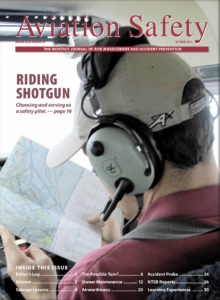- Night Moves
- Other Approaches
- Go/No-Go Decisions
- Fudging Performance
- Trim Stalls
To continue reading this article or issue you must be a paid subscriber. Sign in
Subscribe to Aviation Safety
Start a subscription to Aviation Safety for just $74 and access all of our online content - over 2,000 articles - free of charge.
Subscribe today and save 19%. It's like getting 2 months FREE!


Why can’t I download my subscription???
As is the norm for Bob Wright, he covered the PNW bases fairly well. Unmentioned, however are two very significant issues, one excessively broad geralization, and a ‘gotcha’ airspace managed by the US Department of Commerce.
First, the generalization of “wlilderness”. In the PNW ter are literally millions of acres of Congressionally designated Wilderness. These Congressionally designated areas are managed primarily by the USDA Forest Service, but also occur within National Parks, and Bureau of Land Management public lands (the original ‘BLM’). Note the capital “W”. These areas often have no airports or airstrips suitable for safe emergency fixed wing operations. In nearly all cases roads are prohibited, as are unauthorized motorized tools and conveyances. With the exception of a very few back country airstrips landing any unauthorized aircraft on Federal lands can get a pilot into a heap a trouble that can be both time consuming and expensive to resolve. For convenience we can lump millions more acres of “roadless areas” into the “W” category as similar restrictions often apply.
Second — Anyone who has flown in any state the author lumped onto his “PNW” region is well aware that summer smoke from wildfires, ‘prescribed’ burning, and ‘fires for resource benefit’ can create IMC and pretend VMC (PVMC) that may blanket entire states. PVMC might theoretically meet the 3 mile VFR criteria if flying away from the sun, but be a world of dense haze otherwise.
Third — Of course, where there are large wildland fires there are often TFRs. It is not unusual to have multiple TFRs that block passes, low terrain, valleys, access to airpots (big and small), and preferred routes used by pilots of normally aspirated aircraft. Generally, TFRs will extend 3,000′ above the highest terrain within the restricted airspace. But!! in several instances each year I find TFRs with published ceilings that may be 4,000′ or even higher above the highest terrain. And, of course, where there is fire and smoke fire fighting aircraft congregate. In other words, things can get VERY congested over, in, and within 10- 15 nm of a wildfire TFR. Unsurprising to all pilots, most of the fixed wing retardant aircraft make frequent trips to a retardant base located on an airport. In VFR or PVFR they may fly at the same altitudes as GA piston engine aircraft. Pilots of float equipped private aircraft should also be aware of numerous helicopters that are likely to operate near both TFRs and on smaller fires. Other fixed wing retardant aircraft may travel between a TFR and a nearby river or lake to scoop water. Those water scooping aircraft may also be working smaller fires that won’t have a TFR. The current fleet of firefighting aircraft is very diverse. It includes heavy jets and prop aircraft, light jets, small turboprops, twin engine pistin and single engine piston aircraft. In addition, large numbers of helicopters of various sizes may operate over fires that may or may not be witin a TFR. Pilots unfamiliar with PNW summer fire seasons should also consider the amazing congestion that can occur virtually instantaneously at both towered and rural non-towered airports when a wildfire event occurs.
As is the norm for Bob Wright, he covered the PNW bases fairly well. Unmentioned, … a ‘gotcha’ airspace managed by the US Department of Commerce.
Large chunks of the PNW Pacific coastal waters from the shore to the extent of Marine Sanctuaries have airspace restrictions established by the US Department of Commerce. The airspace above numerous off shore rock features is also restricted. Violation of the restricted airspace can result in substantial fines. Anyone planning to fly along the Pacific coastline of Washington and Oregon should do their homework before venturing out over the water.